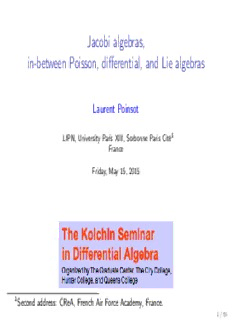
Jacobi algebras, in-between Poisson, differential, and Lie algebras PDF
Preview Jacobi algebras, in-between Poisson, differential, and Lie algebras
Jacobi algebras, in-between Poisson, differential, and Lie algebras Laurent Poinsot LIPN,UniversityParisXIII,SorbonneParisCité1 France Friday,May15,2015 1Second address: CReA, French Air Force Academy, France. 1/60 Table of contents 1 Motivations 2 A glance at universal (differential) algebra 3 Differential Lie algebras and their enveloping differential algebras 4 The embedding problem 5 Jacobi, Poisson and Lie-Rinehart algebras 6 Kirillov’s local Lie algebras and Lie algebroids 2/60 Lie algebras Definition Let R be a commutative ring with a unit. A Lie algebra (g,[−,−]) is the data of a R-module g and a bilinear map [−,−]: g×g → g, called the Lie bracket, such that It is alternating: [x,x] = 0 for every x ∈ g. It satisfies the Jacobi identity [x,[y,z]]+[y,[z,x]]+[z,[x,y]] = 0 for each x,y,z ∈ g. A Lie algebra is said to be commutative whenever its bracket is the zero map. 3/60 Actually this defines a functor from the category Ass to the category Lie. This functor admits a left adjoint namely the universal enveloping algebra U(g) of a Lie algebra g. One has U(g) (cid:39) T(g)/(cid:104)xy −yx −[x,y]: x,y ∈ g(cid:105) where T(M) is the tensor algebra of a R-module M. Universal enveloping algebra Any (say unital and associative) algebra (A,·) may be turned into a Lie algebra when equipped with the commutator bracket [x,y] = x ·y −y ·x . 4/60 One has U(g) (cid:39) T(g)/(cid:104)xy −yx −[x,y]: x,y ∈ g(cid:105) where T(M) is the tensor algebra of a R-module M. Universal enveloping algebra Any (say unital and associative) algebra (A,·) may be turned into a Lie algebra when equipped with the commutator bracket [x,y] = x ·y −y ·x . Actually this defines a functor from the category Ass to the category Lie. This functor admits a left adjoint namely the universal enveloping algebra U(g) of a Lie algebra g. 4/60 Universal enveloping algebra Any (say unital and associative) algebra (A,·) may be turned into a Lie algebra when equipped with the commutator bracket [x,y] = x ·y −y ·x . Actually this defines a functor from the category Ass to the category Lie. This functor admits a left adjoint namely the universal enveloping algebra U(g) of a Lie algebra g. One has U(g) (cid:39) T(g)/(cid:104)xy −yx −[x,y]: x,y ∈ g(cid:105) where T(M) is the tensor algebra of a R-module M. 4/60 PBW Theorem If R is a field, then j is one-to-one. More generally, P.M. Cohn proved in 1963 that if the underlying abelian group of g is torsion-free, then j is one-to-one. Remark Actually, PBW theorem states that the associated graded algebra of U(g) and the symmetric algebra of g are isomorphic. Poincaré-Birkhoff-Witt theorem Let g be a Lie algebra (over R). Let j: g → U(g) be the Lie map defined as the composition π g (cid:44)→ T(g) −→ U(g) (where π is the canonical projection, and U(g) is seen as a Lie algebra under its commutator bracket). 5/60 Remark Actually, PBW theorem states that the associated graded algebra of U(g) and the symmetric algebra of g are isomorphic. Poincaré-Birkhoff-Witt theorem Let g be a Lie algebra (over R). Let j: g → U(g) be the Lie map defined as the composition π g (cid:44)→ T(g) −→ U(g) (where π is the canonical projection, and U(g) is seen as a Lie algebra under its commutator bracket). PBW Theorem If R is a field, then j is one-to-one. More generally, P.M. Cohn proved in 1963 that if the underlying abelian group of g is torsion-free, then j is one-to-one. 5/60 Poincaré-Birkhoff-Witt theorem Let g be a Lie algebra (over R). Let j: g → U(g) be the Lie map defined as the composition π g (cid:44)→ T(g) −→ U(g) (where π is the canonical projection, and U(g) is seen as a Lie algebra under its commutator bracket). PBW Theorem If R is a field, then j is one-to-one. More generally, P.M. Cohn proved in 1963 that if the underlying abelian group of g is torsion-free, then j is one-to-one. Remark Actually, PBW theorem states that the associated graded algebra of U(g) and the symmetric algebra of g are isomorphic. 5/60 Yes. And even (at least) two different ways. The first one is a somewhat “trivial” extension. Indeed, a derivation on an algebra is also a derivation for its commutator bracket. Moreover the universal enveloping algebra may be equipped with a (universal) derivation that extends the derivation of the Lie algebra, and the Poincaré-Birkhoff-Witt theorem remains unchanged. The other one is rather different (since it is not based on the commutator) and is sketched hereafter. Question Is there a way to extend the notion of universal enveloping algebra to the differential setting? 6/60
Description: